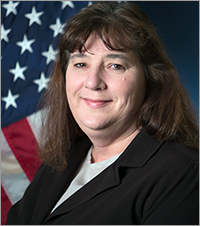Gather with your colleagues
The plenary session is one of the highlighted events of the meeting, allowing participants from each symposia to come together and recognize some of the greatest minds in the field.
Incoming ECS President Christina Bock will wrap up the first full day of the 236th ECS Meeting by welcoming meeting attendees and introducing the highly anticipated lecturer, Valerie Browning from DARPA’s Defense Sciences Office (DSO). Her talk is “DARPA Advances in Electrochemistry and Solid State Science and Technology.”
The agenda also includes the presentation of:
- Olin Palladium Award of the Electrochemical Society
- Carl Wagner Memorial Award of the Electrochemical Society
Be sure to add the talks of the Society, division, and section award winners to your meeting online program; they are in various symposia throughout the week. The recipients of these awards will be announced and scheduled this summer.
The ECS Lecture
Monday, October 14 | 1700h
Location: Grand Salon West
“DARPA Advances in Electrochemistry and Solid State Science and Technology” by Valerie Browning, DARPA’s Defense Sciences Office (DSO)”
 Valerie Browning has served as the director of DARPA’s Defense Sciences Office (DSO) since December 2017. She has over 35 years of experience in managing and executing defense-related research and development (R&D). Prior to her current assignment, she worked as an independent consultant providing subject matter expertise and strategic planning support to the Department of Defense, the Department of Energy, and other government clients. She also served as CTO for HELM System Solutions, Inc., a woman-owned small R&D business.
Valerie Browning has served as the director of DARPA’s Defense Sciences Office (DSO) since December 2017. She has over 35 years of experience in managing and executing defense-related research and development (R&D). Prior to her current assignment, she worked as an independent consultant providing subject matter expertise and strategic planning support to the Department of Defense, the Department of Energy, and other government clients. She also served as CTO for HELM System Solutions, Inc., a woman-owned small R&D business.
Browning was a program manager in the DSO from 2000 to 2007, where she initiated and managed a diverse R&D portfolio in areas that included metamaterials, bio-magnetics, unmanned underwater vehicle (UUV) energy storage, portable power, thermoelectric materials, and others. She also worked as a research physicist at the Naval Research Laboratory from 1984 to 2000, where her areas of research included thermoelectrics, superconductors, magnetics, and magnetic oxide materials.
This presentation will highlight past and current DSO investments in electrochemistry and solid state science and technology. Exemplar applications in UUV energy storage and portable power enabled by DARPA DSO investments will be reviewed. The presentation will also provide insight regarding how DARPA programs are generated and what might be on the horizon for future areas of interest.
Abstract
The DSO at DARPA has been actively supporting the advancement of materials science for nearly six decades. In the early 1960’s DARPA established Interdisciplinary Laboratories (IDL), which were intended to support interdisciplinary research, bring together metallurgists, physicists, and chemists, to address the biggest challenges facing the development of materials and material systems for Department of Defense applications. The IDLs became the genesis of the field of materials science, enabling a wide range of material breakthroughs such as rare earth magnets, conductive polymers, and nonlinear optical materials. DARPA’s investments in materials science have continued and expanded over the last 60 years yielding significant developments in electronic, structural, functional, and electrochemical materials and systems. For example, in the areas of electrochemistry and solid state science and technology, DSO supported the development of advanced energy storage, electrochemical, and solid state energy conversion materials and systems. Today, DSO is supporting the development of electrochemical approaches towards the assembly of nanometer to micron-scale components to achieve improved functionality for a broad range of important national security applications.
This presentation will highlight DARPA DSO’s past and current investments in electrochemistry and solid state science and technology. Exemplar applications in unmanned underwater vehicle energy storage and portable power enabled by DARPA DSO investments will be reviewed. In addition, the presentation will provide insight regarding how DARPA programs are generated and what might be on the horizon for future areas of interest.




